 At a Glance
At a GlanceExpert's Rating
Pros
- Minimal CPU, memory usage
- Truly built to protect your privacy
Cons
- Unclear how widespread BAT will become
- Signing up to accept BAT requires a ton of info
Our Verdict
Brave’s first browser is a fast, lean, browser that takes your privacy seriously. And it can pay you, too, with its blockchain integration.
Brave Software’s new Brave browser, which emerges out of a long beta into a full-fledged Brave 1.0 release today, works in two ways: As a privacy-minded browser that does everything it can to minimize your footprint on the Web, and as a convoluted means of paying people who provide you the content that you read daily.
It’s been literally years since Brendan Eich, the creator of JavaScript and the co-founder of Mozilla, first spoke to PCWorld about trying to balance privacy and ensuring that those that created content were paid for their efforts. The compromise was what Brave Software now calls the Basic Attention Token, or BAT, which leverages the Ethereum blockchain as a unit of virtual currency.
Brave not only allows you to accumulate BAT, via ads that slide in as system notifications once per hour or so, but also to receive BAT that’s either paid or “tipped” to you by other users or readers. You can take some of that BAT to “pay” other users, or store it. Eventually, Brave says, you’ll be able to trade it in for gift cards or other services.
For now, though, I found Brave as very much in keeping with the current emphasis on privacy, above and beyond what users have already established with ad blockers and other add-ons to prevent scripts from running on their PC. Brave won’t probably overcome Chrome or even Microsoft’s Edge, but I could see the “millions” of users the browser has reportedly accumulated becoming a devoted cult following. In a good way, of course.
 Mark Hachman / IDG
Mark Hachman / IDG
Brave has probably the best “new tab” screen of any browser: killer image, shortcuts to popular sites, as well as a summary of what Brave’s privacy features have done for you.
Brave’s browser delivers excellent performance
Like many browsers today, including the new Microsoft Edge, the Brave browser is built upon Chromium, the foundation of Google Chrome. Brave tweaked the open-source Chromium code, including weeding out the Google-specific code that ties the browser to Google Web services. Brave runs extensions from the Chrome Web Store, though it will warn you if it thinks you’re installing a dodgy one.
By now, browsers absolutely have to be free and extremely simple to configure. Brave easily clears the first hurdle, though setup is a subtly complex process. It’s easy to get up and running fast, but Brave’s more advanced features require some fiddling. Brave slurped up my favorites, websites, passwords, and other necessities from Chrome, however, and had me browsing happily in just a minute or so.
As with other browsers, a single master password allows you to sync this information with other instances of the Brave browser, as well as a complementary Android browser that I didn’t test. (If two-factor-authentication is available, I missed it. A search box for the settings would be helpful.) I say “password,” but even this isn’t that simple; you’ll need to establish a “synch chain” with another computer or phone, then enter a Brave-suggested password to connect them. Mine was 24 words. Yes, 24 words.
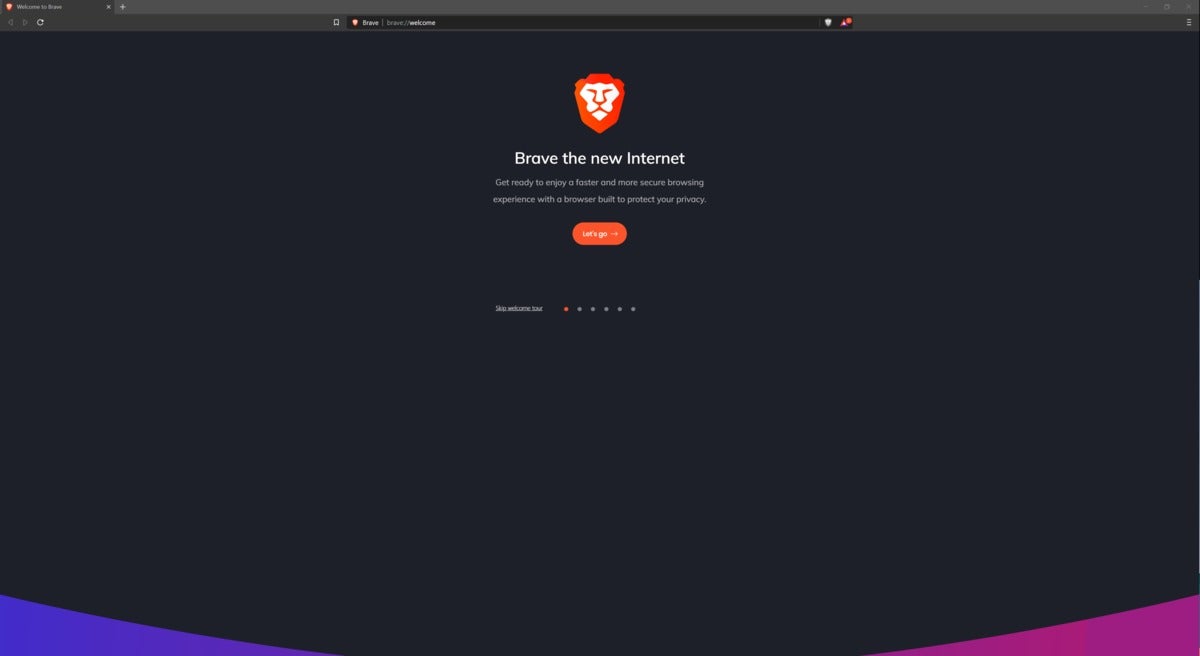 Mark Hachman / IDG
Mark Hachman / IDG
Brave walks you through a short setup process.
Performance is also table stakes, and the Brave browser is right in the middle of the pack. The distinctions are so slight, however, you’ll probably never notice a shift in performance between one browser and another. We did use three modern Web benchmarks, however, to measure performance between Brave, Chrome 78, the current Edge 44, and Firefox 70. (We’ll wait for the “new” Chromium-based Microsoft Edge to be released before adding it.)
WebXPRT is probably the closest to a “real-world” test of Web apps like photo manipulation and text editing, with the other two focusing more on the basic functions underlying Web applications and general browsing.
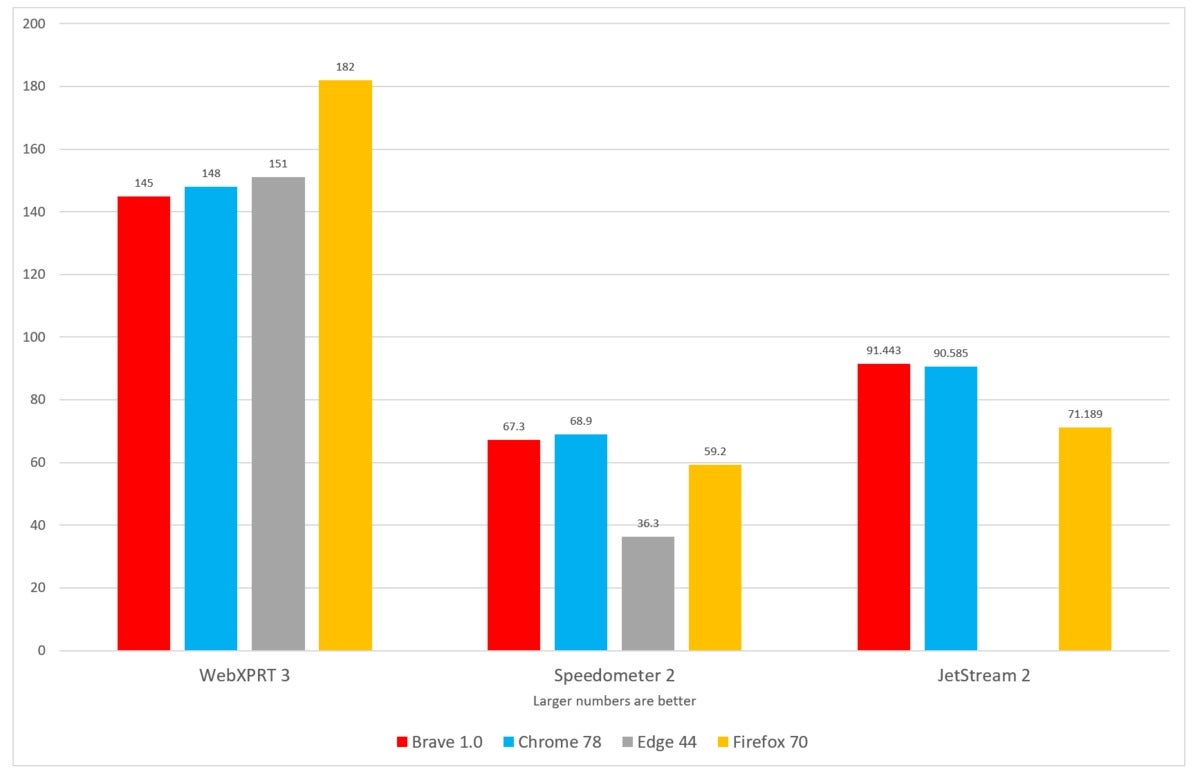 Mark Hachman / IDG
Mark Hachman / IDG
Brave doesn’t finish at the top of these Web-based benchmarks, but it’s close enough to not make a significant difference.
For whatever reason, the current Edge posted disastrous scores in our testing, though we also used more modern benchmarks than we normally run in our best browsers roundup. (Edge flat-out didn’t run the JetStream 2 benchmark.) All tests were performed on the recently-released Surface Laptop 3, using the Ryzen 5 version of the Surface Edition chip and 16GB of memory.
We also loaded up all four browsers with 30 tabs of media-rich Web sites, including CNN, ESPN, Comedy Central, and our own. Doing so is a bit controversial, for one reason: Brave blocks ads natively, like another niche browser, Opera, which should help both browsers reduce their memory and CPU load. Still, for those who don’t tune their browsers with ad blockers and tools to block scripts, it’s another indication how clean Brave’s browser runs by default.
We loaded each tab until we reached the required thirty, then measured the memory and CPU load after a minute. The results aren’t exactly comparable, since we were loading live sites with live content; on the other hand, it’s a good snapshot of real-world performance. Brave also rendered sites that were also immediately responsive.
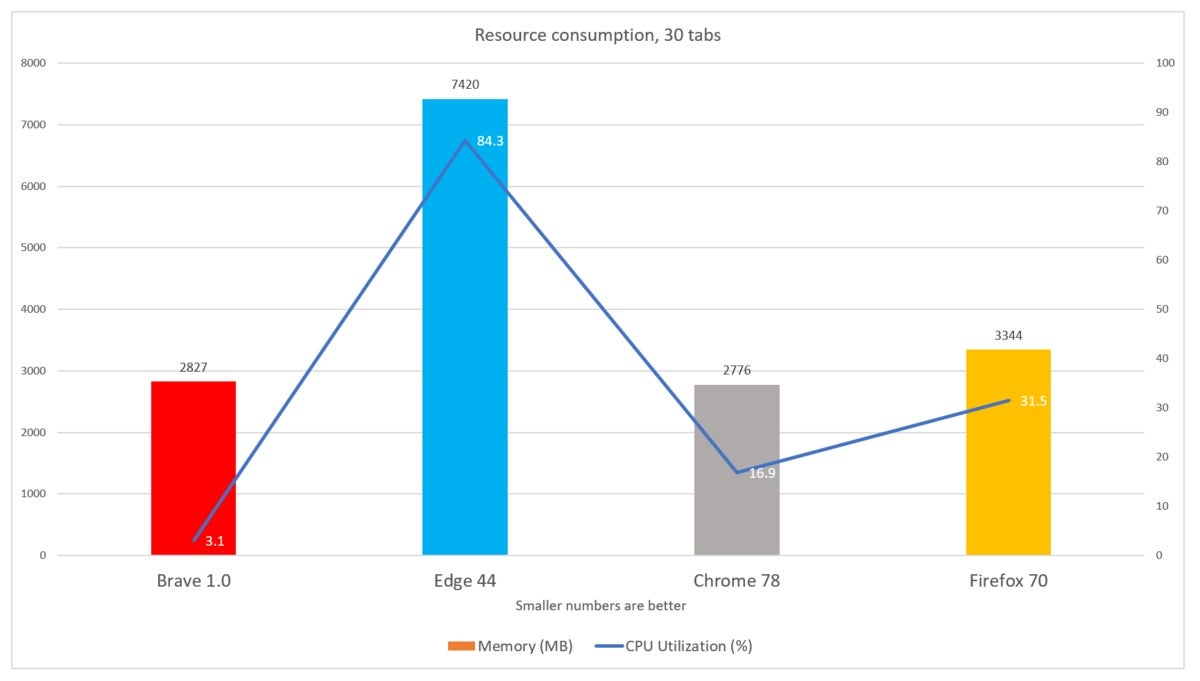 Mark Hachman / IDG
Mark Hachman / IDG
In this chart, we show memory usage in thousands of megabytes (gigabytes) on the left, with CPU utilization on the right. Brave does excellently here.
CPU utilization will bounce all over the place as various Web elements are loaded and processed, so take the CPU results with a grain of salt—they can vary by more than ten percent from second to second. In general, though, Brave easily outperformed all of the other browsers we tested in terms of CPU utilization, with comparable memory performance to Chrome. That’s the power of nuking tracking scripts out of the gate, and a solid reason to use Brave.
Built for privacy, and more
Whether online or in the virtual world, saying “no” constantly can be exhausting. Brave does it for you, but allows you to reach out and engage with those sites you choose to. We’ll talk a bit more about actually rewarding those sites in the next section.
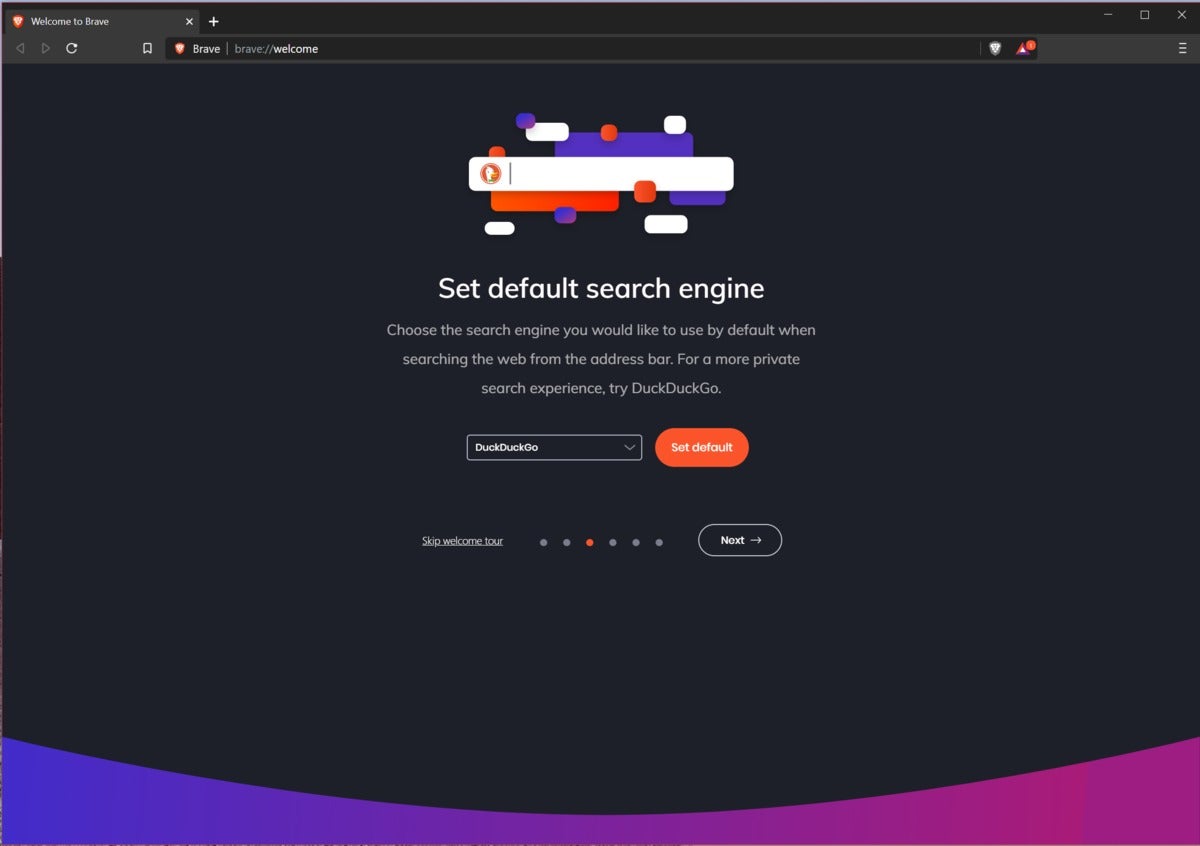 Mark Hachman / IDG
Mark Hachman / IDG
DuckDuckGo, a privacy-minded search engine, is Brave’s preferred choice, though you can select whatever you want.
Next to each URL in the URL bar is a small “shield” icon, with a Brave lion painted in orange. By default (configurable in the Settings and during setup), shields are “up,” like in Star Trek. Shields can block third-party sites from tracking you around the Web, like Facebook, or third-party advertising services. You can prevent scripts from running, though that’s not on by default. Cross-site cookies—cookies that help identify you as you move from site to site—are also blocked, as well as the collection of various elements of your PC (your IP address, OS, and CPU string, for example) that can allow an advertiser to guess your identity without a dedicated ID. If there’s a secure HTTPS connection, Brave will attempt to connect to it.
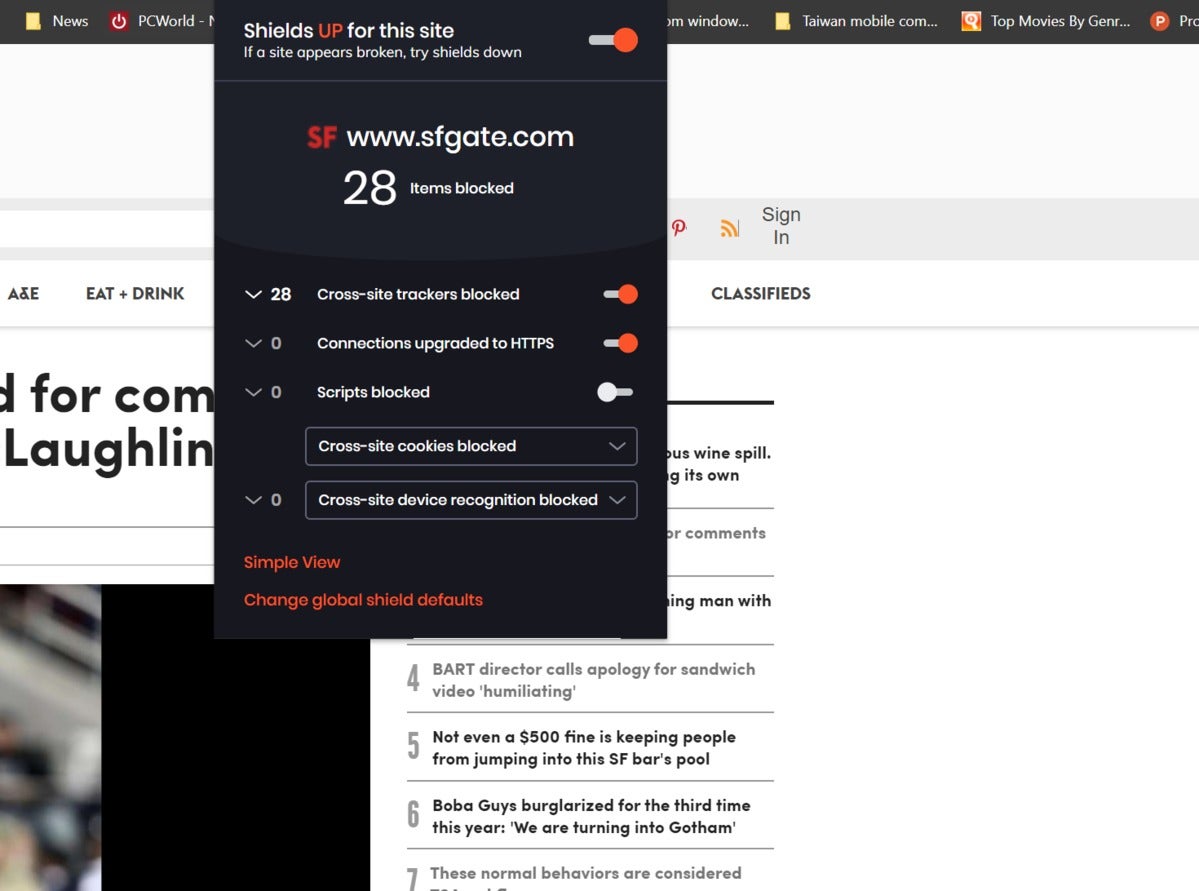 Mark Hachman / IDG
Mark Hachman / IDG
Clicking on the “shield” icon summarizes all that Brave is doing it for you, and allows you to option to fine-tune things even further.
You’ll also notice small icons that may appear from time to time, alerting you that autoplaying videos were blocked automatically. You can block social media, too, including LinkedIn posts or embedded Twitter tweets. All of these are designed to smooth your browsing experience. And yes, ads are blocked automatically, though you can add additional ad blocklists via the Settings menu. It all adds up to a pleasing, ad-free experience.
Brave also understands that there’s surfing privately, and then there’s surfing privately. Microsoft may have won kudos for the privacy rules it’s enforcing within InPrivate Mode within the new Edge, but Brave goes even further. Not only can you open a private window, but you can open an even deeper level of privacy and use the Tor onion-routing network as well. Tor allows you to mask your identity even more securely—and, if you choose, wander through the Darknet, the Web-beneath-the-Web.
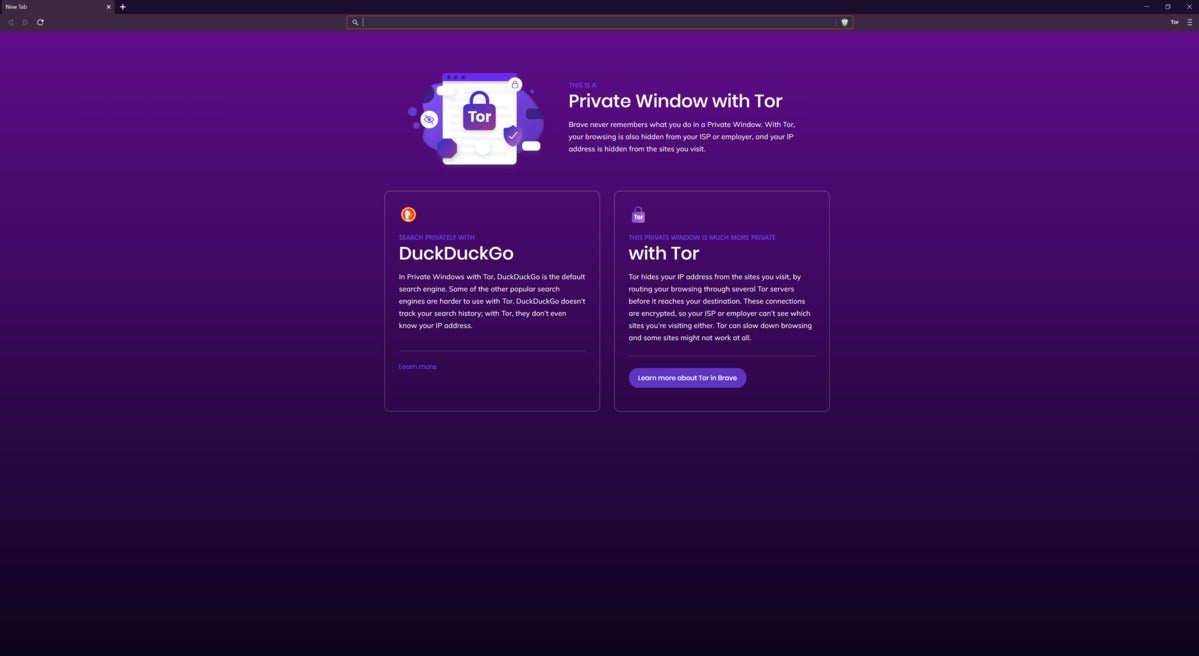 Mark Hachman / IDG
Mark Hachman / IDG
Brave helps push the Tor browser mainstream, though browsing the deep Web without additional protections makes me leery.
I didn’t see a lot in Brave’s documentation describing sandboxing or any other protections against malware, and seeing ads start popping up in the Tor sites I visited made me quickly wonder what the hell I was doing. I’d probably put Brave inside Windows Sandbox before I wandered in again.
There are some additional perks hidden beneath Brave’s surface, too. WebTorrent is natively supported, meaning that you can download torrents right in the browser, or watch BitTorrent distributed videos that use WebRTC as a transmission method. Hangouts are supported. Brave can also manage your cryptocurrency wallets: Ledge, Trezor, or another crypto wallet right from your browser. Even casting to a Chromecast is supported, although not on by default.
 Mark Hachman / IDG
Mark Hachman / IDG
Diving into the Settings reveals what else Brave has in store.
Brave’s BAT: a wild card that might pay off
But if a browser like Brave seals off all sorts of advertising and ad tracking, how then, does a site like (cough) PCWorld make money? Brave’s answer to that is the Basic (why not “Brave”?) Attention Token, or BAT. Set at about 4.38 BAT to the dollar, Brave allows you to make money via ads, as well as ship BAT off to sites or other users. Brave calls this Brave Rewards, in much the same way that Microsoft also allows you to slowly build up stored points though Microsoft Rewards.
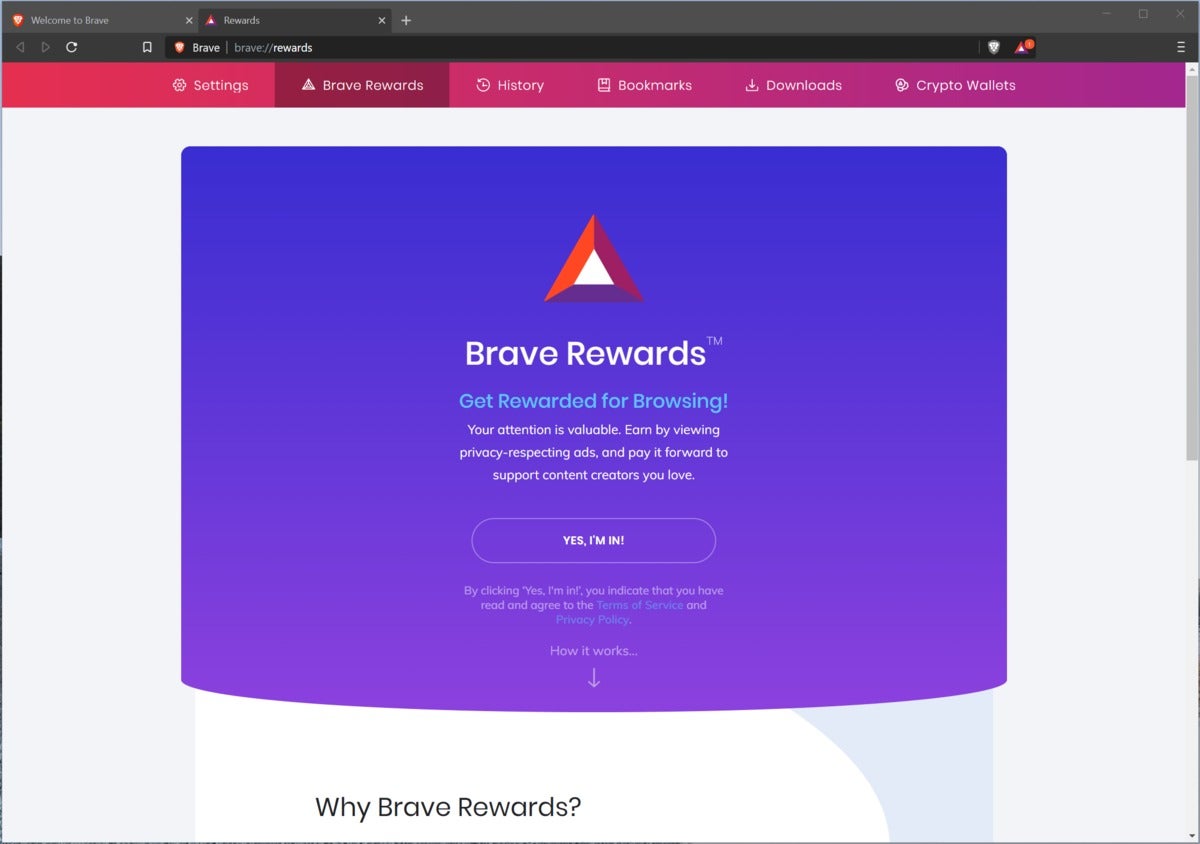 Mark Hachman / IDG
Mark Hachman / IDG
Brave Rewards is part and parcel of the Brave browser experience.
On paper, BAT sounds attractive. If an advertiser pays Brave a dollar, you get 70 cents of it, or whatever that is in BAT. Oh, wait—did you think that you’d have an ad-free experience?
Well, yes, you can, but Brave would like you to see some ads, just not the ones generated by websites themselves, so it will pay you to do so. These ads slide in as system notifications—text ads, yes, but they’ll slide out as just another notification from your Windows’ Action Center. It all feels just a tad sleazy, like a violation of one of the last ad-free spots on your PC. Again, though, you have the option of turning off ads entirely, or alternatively, dialing them up to five per hour.
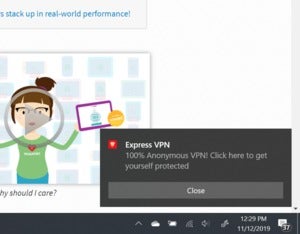 Mark Hachman / IDG
Mark Hachman / IDG
This is what a Brave browser ad looks like as it slides in.
If you dial it down, however, you’ll likely exhaust your BAT storehouse of accumulated funds from ads—or worse, never start accumulating them at all. And if you don’t, that gives you even less incentive to use them to tip creators, which is the foundation of the tit-for-tat reciprocity relationship Brave is trying to foster with its browser.
Assuming you do buy in, though, you’ll have some interesting options.
Probably the most frustrating, right now, is the option to simply “tip” a site or person for an outstanding tweet, article, or other post. Clicking the small pyramid in the URL bar brings up the site’s Brave Rewards status—which, especially at this early stage, is almost uniformly not verified, and therefore can’t receive BAT. Yes, sites have to officially buy into Brave’s vision to receive compensation, which seems like a big ask for a niche browser that blocks native advertising by default.
 Mark Hachman / IDG
Mark Hachman / IDG
If you do find someone who’s verified, sending them a BAT “tip” is easy.
Each tweet within Twitter’s site also has a small Rewards pyramid next to it, too, but its legions of oblivious tweeters aren’t signed up, either. Tipping a work acquaintance 1 BAT (about 25 cents) for a nice tweet sounds fun, but unless you pester them to join Brave, they’ll be as poor as ever.
I can totally see savvy freelancers signing up for BAT eligibility in droves as a way to make a few extra bucks per month, though. Maybe Brave’s counting on that?
Conversely, Auto Contribute is probably the most interesting and practical way of spending BAT. Instead of laboriously seeking out verified Brave users and giving them BAT, Auto Contribute does it automatically—and smartly, too. Brave figures out the attention you’ve given various sites, and divvies up a scheduled monthly contribution among them. Even better, it identifies Brave-verified sites in your list of sites, so you’ll know that you can also tip them, too. Theoretically, you should be able to adjust your BAT “income” and “payments” so that each balance out.
 Mark Hachman / IDG
Mark Hachman / IDG
Brave automatically figures out where you should be putting your BAT.
Simple, right? Mostly.
It’s easy to work within the BAT ecosystem. Taking money, real money, out of BAT is another thing altogether, though. For that, you’ll need to verify your account with Uphold, a third-party service. And since Uphold is apparently subject to finance laws, you’ll need to submit a ton of personal information, including name, address, birthdate, and so on. You’ll also need to take a digital photo of your ID and a selfie, to prove you’re you. I foolishly entered the wrong birthdate and clicked enter by accident—and that’s the one piece of information you can’t easily change.
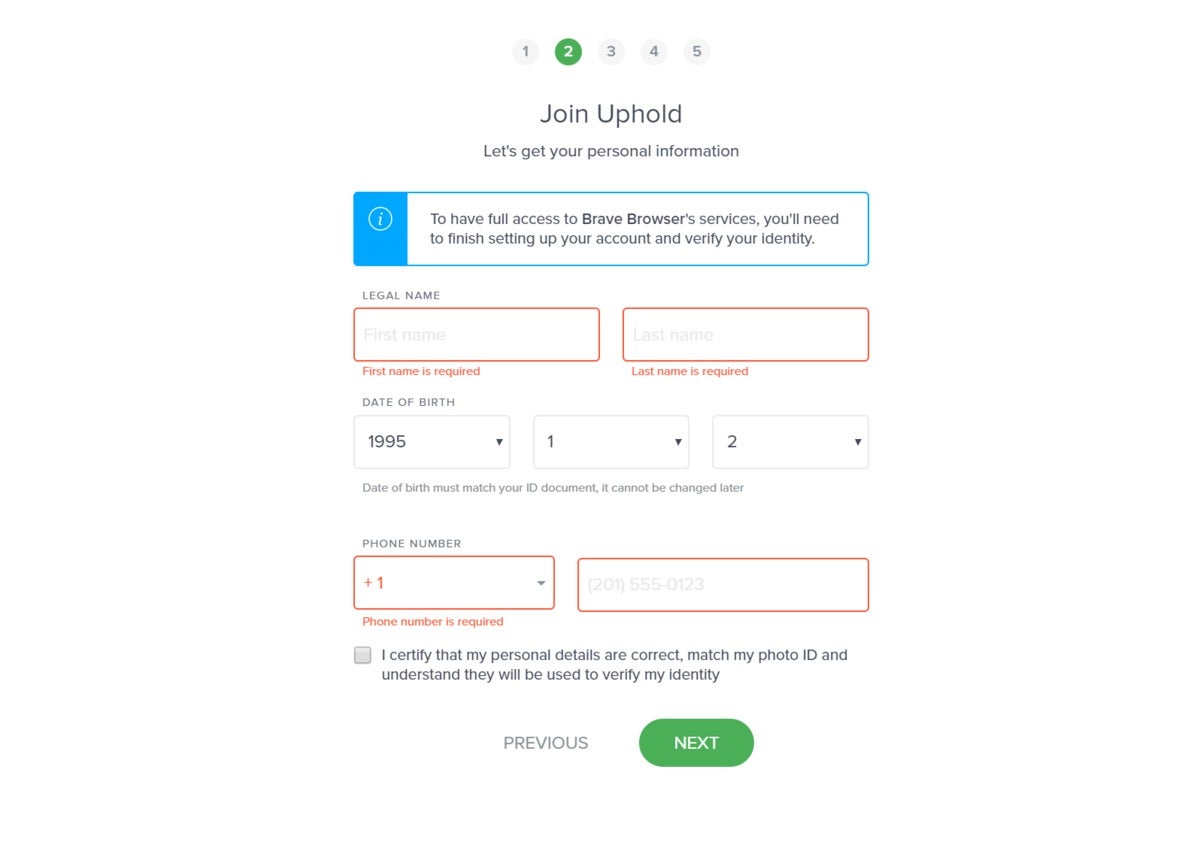 Mark Hachman / IDG
Mark Hachman / IDG
Uphold’s BAT verification process gets very serious, very quickly.
Jason Cross, a colleague, called the Uphold process easy, and perhaps it actually is. But after being forced to go through support, and after worrying that I’m handing off personal information to yet another site that could be potentially hacked, I’m doubtful. Isn’t my paycheck just enough as it is?
It’s possible, as I noted earlier, that Brave could be the next big thing for the gig economy, in much the same way Venmo quietly took over an enormous chunk of the person-to-person payments market. But given the significant effort required by both users and sites for the blockchain-backed BAT payment options to work as envisioned, it might not take take the world by storm. Right now, however, I prefer to look at the Brave browser as a well-thought-out, privacy-focused browser that’s very much worth looking at for those reasons alone.
I’m an admitted cheapskate, however, and the $5 per month that Microsoft Rewards throws my way just for using Bing as a daily search engine funds a Starbucks every so often. Will I probably sign up for BAT soon? Why not? I try to balance dad jokes on Twitter with some solid professional insight—and after all, those lattes aren’t going to buy themselves.
